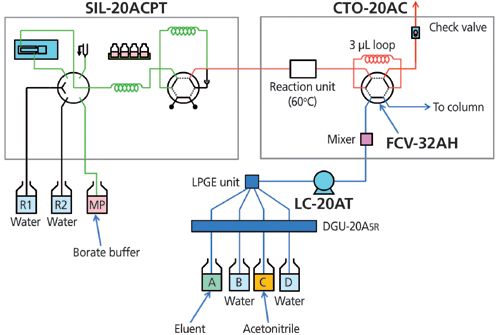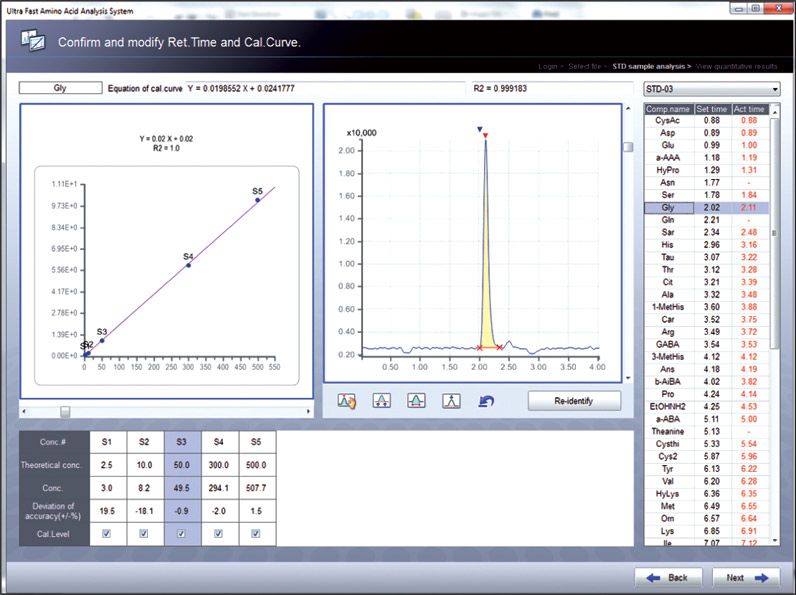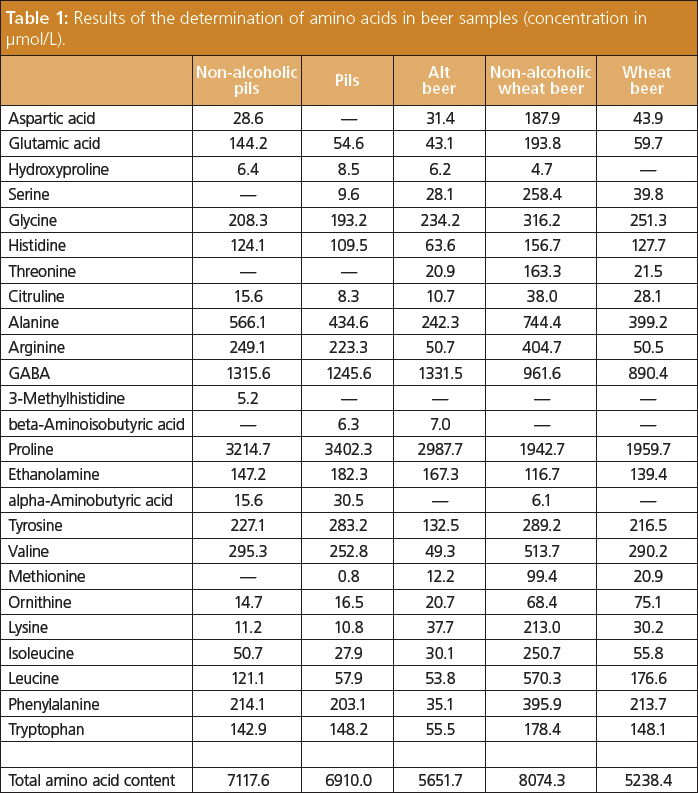Fast and Simple Determination of Free Amino Acids in Beer
Beer is one of the most popular drinks in the world. Based on natural products, quality control to guarantee a product of consistent taste, colour, and composition can be challenging. Amino acids analysis can be used to ensure consistency in the quality of the end-product, and also as an indicator for counterfeiting of branded products. In this article we present a rapid and reliable high performance liquid chromatography–mass spectrometry (HPLC–MS) method to determine amino acids in beer.
Beer is one of the most popular drinks in the world. Based on natural products, quality control to guarantee a product of consistent taste, colour, and composition can be challenging. Amino acids analysis can be used to ensure consistency in the quality of the end-product, and also as an indicator for counterfeiting of branded products. In this article we present a rapid and reliable high performance liquid chromatography–mass spectrometry (HPLC–MS) method to determine amino acids in beer.
With an annual consumption of approximately 200 million kilolitres,1 beer is one of the most popular beverages in the world. It is sold in a huge variety of styles and flavours: with or without alcohol; pure or as a mixed drink; as an ale, lager, pils, wheat-beer, Koelsch, or Alt, to name just a few. Apart from the risks of overindulging in alcoholic beverages, beer is not all bad. It is easily digestible and offers an important source of vitamins, potassium, magnesium, phosphor, and other trace elements, as well as proteins such as free amino acids.2

Photo Credit: Level1studio/Getty Images
The composition of beer wort, the liquid extracted from the mashing process during the brewing of beer, is largely dependent on the raw materials and the style of brewing used in the production process.
Even though the brewing water and quality and character of hops and barley can be controlled, environmental influences can lead to small variations in the concentration of the constituents and therefore its quality: the contribution of specific amino-acids in the formation of off-flavours as well as a positive effect of others on fullness and drinkability has been established.3,4 In addition the significance of amino acids as a source of nitrogen for fermentation is indisputable.5
Determination of changes in the composition and content of amino acids from after-harvest barley grain maturation to the finished beer is therefore an important measure in ensuring the consistency in quality of the end-product. Quantification of specific amino acids can also offer an indication of adulteration and degradation during processing and storage or identification of counterfeiting of branded products.
Method: Amino Acid Analysis
There are many options for the analysis of amino acids, for example without derivatization, using a HILIC approach,6 o-phthalaldehyde (OPA) pre-column derivatization and fluorescence detection,7 OPA pre-column derivatization and UV-detection,8 or ion-exchange chromatography and post-column derivatization.9 In this study, an automated pre-column derivatization and on-line reversed-phase LC separation with a UF-Amino station (Shimadzu) was used, in combination with an LCMS 2020 single quadrupole mass spectrometer (Shimadzu) for detection. The advantages of automated derivatization include an increase in speed and efficiency and a reduction in the risk of human errors in the analytical workflow.
The chemicals used were an amino acid analysis reagent (for LC–MS) (AminoTag), an amino acids mixture standard solution, Type AN-2 and Type B, APDSTAG amino acids internal standard mixture solution, and AminoTag Eluent, all sourced from Wako Chemicals GmbH. MS-grade acetonitrile (Promochem) was used as mobile phase B. From the concentrated amino acids standard mixture a series of calibration standards with concentrations of 500 μmol/L, 300 μmol/L, 50 μmol/L, 10 μmol/L, and 2.5 μmol/L was prepared.

Figure 1: Flow diagram for derivatization and injection into the system.
Five beers from different manufacturers of different make and variety were sampled as test probes, including alcohol-free pils and wheat beer, alcohol-containing pils and wheat beer, and an Alt beer from the German Düsseldorf region.
Blank samples, calibration standards, and beer samples (after filtration) were all treated in the same way. Measures of 50 μL of the probe (water for the blank), 50 μL of internal standard solution (water for the blank), and 100 μL of acetonitrile were filled in deep well plate tubes and thoroughly mixed.
Pretreatment was performed automatically in the autosampler, where the probe was combined with borate buffer solution and the amino acid reagent and injected. Derivatization was completed in the reaction unit at 60 °C before forwarding the amino acid derivatives obtained onto the analytical column (2.1 × 100 mm, 2.0 μm Shimpack UF-Amino) with subsequent detection using MS.
Derivatization of a second sample was performed during analysis of the first probe, resulting in considerable time-saving during the course of the experiment.
Programming of the analysis and evaluation of the resulting data was carried out using AmiNavi software (Shimadzu Corporation and Ajinomoto). After entering the sample names, a batch with the desired number of standards, blank injections and samples was created and illustrated via colour highlighting of the positions of the individual substances in the deep-well plate (Figure 2).

Figure 2: Colour highlighting of the individual sample positions in the batch.
Results and Discussion
Calibration curves for each analyte of interest were created according to the preset reprocessing method. Integration of the individual compounds was verified and manually corrected, if necessary (Figure 3). The results of the quantification of the 38 amino acids included in the analytical method in the five beer samples are given in an overview table as well as a display of individual chromatographic data.

Figure 3: Calibration curve of the individual substances.
The amino acid content of the five beer samples was determined and is displayed in Table 1. Figure 4 shows a typical high performance liquid chromatography coupled to mass spectrometry (HPLC–MS) chromatogram of an amino acid mixed standard solution. The beers differed in amino acid pattern. The highest total amino acid content was found in alcohol-free beers (8074 μmol/L and 7117.6 μmol/L), followed by the pils (6910 μmol/L). The smallest amount of free amino acids (5238 μmol/L) was present in wheat beer. From the 38 analytes measured, the concentration of 11 amino acids was significantly higher in alcohol-free wheat beer than in the other samples tested. These can be separated into three distinctive taste groups: bitter-tasting amino acids (leucine, isoleucine, lysine, arginine, valine, and methionine); sweet amino acids (serine, threonine, and alanine); and sour, umami-taste amino acids (aspartic acid and glutamic acid).10 The most abundant amino acids in all five beer samples were alanine (242–744 μmol/L) and proline (1943–3402 μmol/L), which is in accordance with the finding that proline is not absorbed by yeast during the process of fermentation.11

Table 1: Results of the determination of amino acids in beer samples (concentration in μmol/L).
Conclusion
A rapid and reliable HPLC–MS method for the determination of up to 38 amino acids in 9 min (12 min total run time) using an automated pre-column derivatization approach has been established.

Figure 4: SIM chromatograms of the determination of 38 derivatized amino acids.
Automated derivatization is fast, efficient, and reduces the risk of human error during sample preparation. With this method 38 biogenic free amino acids were determined in 9 min; it requires 1 to 2 h to analyze biogenic free acids by post-column reaction system. With normal pre-column derivatization the number of targeted amino acids is generally limited to 20–25.
The assay showed good reproducibility of the derivatization procedure, as can be seen from the 5-point calibration curves which all produced a linearity of R2 ≥ 0.99. The amount of amino acids in beer depends on the materials and the technology used for beer preparation and is partially responsible for the nutritional value, quality, and stability of the beer. The total content of amino acids in the five beer samples tested varied between 5238 μmol/L and 8074 μmol/L, with significant variability in the amino acid distribution in the different types of beer.
References
1. Kirin Beer University Report http://www.kirinholdings.co.jp/english/news/2014/0108_01.html
2. P. Hofta, P. Dostalek, and D. Sykora, Journal of the Institute of Brewing113, 48–54 (2007).
3. G. Basarova and J. Janousek, Kvasny Prumysl46, 314–318 (2000).
4. Y. Nagao, H. Kodama, T. Yamaguchi, et al., Bioscience, Biotechnology, and Biochemistry63, 468–473 (1999).
5. Dissertation Sven Schönenberg: "Der physiologische Zustand und der Sauerstoffbedarf von Bierhefenunter brautechnologischen Bedingungen" Technische Universität München - Lehrstuhl für Brau- und Getränketechnologie 2.4.4 Der Stickstoffstoffwechsel
6. P Bhandare, P. Madhavan, B.M. Rao, et al., J. Chem. Pharm. Res.2(2), 372–380 (2010).
7. G.L. Lookhart and B.L Jones, Cereal Chem.62(2), 97–102 (1985).
8. M.P. Bartolomeo and F. Malsano, J. Biomol Tech.17(2), 131–137 (2006).
9. J. Csapo, C. Albert, K. Loki, et al., Acta Univ. Sapientiae Alimentaria1, 5–29 (2008).
10. Ajonimoto Group, Food and Amino Acids http://www.ajinomoto.com/features/amino/how/food/
11. Dissertation Sven Schönenberg: "Der physiologische Zustand und der Sauerstoffbedarf von Bierhefen unter brautechnologischen Bedingungen" Technische Universität München - Lehrstuhl für Brau- und Getränketechnologie 4.3.3 Die Aufnahme der Aminosäuren durch die Hefe bei der Propagation
Dr. Gesa Johanna Schad graduated with a diploma in chemical engineering from the Technical University, NTA in Isny, Germany, in 2004 and as a Master of Science in pharmaceutical analysis from the University of Strathclyde in Glasgow, UK, in 2005. She gained her doctorate for research in pharmaceutical sciences at the University of Strathclyde in 2010. Since 2013, she has worked in the analytical business unit of Shimadzu Europa in Duisburg, Germany, as a HPLC product specialist.
Dr. Brigitte Bollig graduated with a diploma in chemistry from the Heinrich-Heine-University in Düsseldorf, Germany, in 2007 and was awarded her doctorate for research in (metal-) organic chemistry and stereoselective synthesis in 2010. In 2011, she started working as a HPLC product specialist with Shimadzu Deutschland, and since 2013 has been employed in the analytical business unit of Shimadzu Europa in Duisburg, Germany.
E-mail: shimadzu@shimadzu.eu
Website: www.shimadzu.eu

Investigating 3D-Printable Stationary Phases in Liquid Chromatography
May 7th 20253D printing technology has potential in chromatography, but a major challenge is developing materials with both high porosity and robust mechanical properties. Recently, scientists compared the separation performances of eight different 3D printable stationary phases.
Analytical Challenges in Measuring Migration from Food Contact Materials
November 2nd 2015Food contact materials contain low molecular weight additives and processing aids which can migrate into foods leading to trace levels of contamination. Food safety is ensured through regulations, comprising compositional controls and migration limits, which present a significant analytical challenge to the food industry to ensure compliance and demonstrate due diligence. Of the various analytical approaches, LC-MS/MS has proved to be an essential tool in monitoring migration of target compounds into foods, and more sophisticated approaches such as LC-high resolution MS (Orbitrap) are being increasingly used for untargeted analysis to monitor non-intentionally added substances. This podcast will provide an overview to this area, illustrated with various applications showing current approaches being employed.
New Method Explored for the Detection of CECs in Crops Irrigated with Contaminated Water
April 30th 2025This new study presents a validated QuEChERS–LC-MS/MS method for detecting eight persistent, mobile, and toxic substances in escarole, tomatoes, and tomato leaves irrigated with contaminated water.
University of Tasmania Researchers Explore Haloacetic Acid Determiniation in Water with capLC–MS
April 29th 2025Haloacetic acid detection has become important when analyzing drinking and swimming pool water. University of Tasmania researchers have begun applying capillary liquid chromatography as a means of detecting these substances.

.png&w=3840&q=75)

.png&w=3840&q=75)



.png&w=3840&q=75)



.png&w=3840&q=75)











